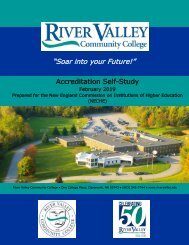Create successful ePaper yourself
Turn your PDF publications into a flip-book with our unique Google optimized e-Paper software.
sections in the same semester to ensure that courses were sufficiently enrolled to allow<br />
them to run.<br />
Considerations were made with regards to timing and location of courses which ensured<br />
that each academic center had options for all students without any one location being<br />
over-saturated with options. The Chair then used this information to develop a datadriven<br />
schedule that allowed for students to meet their academic needs without having so<br />
many sections leading to potential cancellations. As a result of the evaluation, planning,<br />
and thoughtful building of the schedule, <strong>RVCC</strong> has had a decline in cancelled courses and<br />
this, in combination with a concerted effort for early advising and registration, has led to a<br />
stabilization in the schedule.<br />
Program Evaluation<br />
All programs at <strong>RVCC</strong> undergo program review. There are two ways in which this is done.<br />
Programs which have national accreditation are expected to participate fully in whatever<br />
process their accreditation agency requires. This process often involves an eight to tenyear<br />
cycle of self-study, site visit, and review as well as yearly update reports.<br />
Additionally, for programs that are not accredited, there is an internal program review<br />
process which takes place on a rotating cycle and ensures that each program is reviewed<br />
formally.<br />
Over the past few years, the feedback from Program Directors undergoing program review<br />
was that the information being requested was not relevant, and the data required to<br />
answer the questions in the review process was often difficult to access. Having an<br />
outdated program review did not serve to provide the institution with relevant information<br />
related to program success and limited potential for academic planning. As a result of this<br />
feedback, the Department Chairs worked on updating the program review process during<br />
the Fall of 2017 to ensure that the information being collected and reported was easily<br />
accessible, relevant to the information required to determine program viability for the<br />
College, and realistic for Program Directors. In addition to updating the program review<br />
process, the Department Chairs developed a survey for Program Directors to use to assist<br />
them with collection of data. Data included in the program review process is both<br />
formative and summative, qualitative and quantitative. The Program Review has sections<br />
that ask program directors to provide data on topics such as purpose and goals,<br />
admissions, enrollment trends, curricula, faculty and program and student outcomes.<br />
Quantitative questions include items such as: “List program enrollments for the past three<br />
years…” with a qualitative follow up asking “Do you have reason to believe there are<br />
additional students in your program (e.g. second major) that do not show up [in the data<br />
set].” This provides Program Directors opportunities to elaborate on any limitations they<br />
may find in the Veera Bridge data set; thus eliminating the prior complaint about available<br />
data not providing a complete picture.<br />
Upon completion of the program review process, Program Directors provide and present<br />
the review to the Department Chair workgroup which will allow for a discussion about each<br />
program and its effectiveness between the Department Chairs and the Program Directors.<br />
The Department Chair group makes recommendations about the program which may<br />
include suggestions for improvement, continuation without changes, or may, when<br />
22 | P a g e





